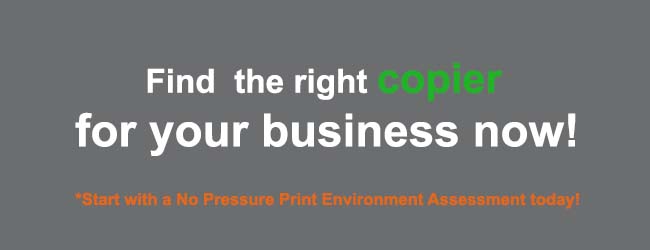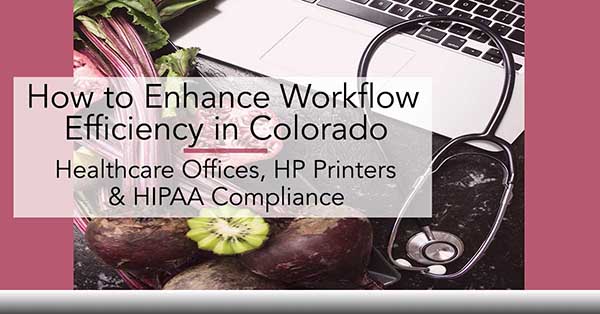In the dynamic world of healthcare, where patient data security and efficiency are paramount, the choice of office equipment and adherence to regulations play a pivotal role. For Colorado healthcare offices, maintaining HIPAA compliance while optimizing workflow is essential. In this blog, we’ll take a look at how incorporating HP printers can help you streamline processes and ensure HIPAA compliance in your Colorado health care office.
How to Enhance Workflow Efficiency Health Offices
Step 1: Understand HIPAA Regulations
Before delving into the specifics of workflow and technology, it’s crucial to understand the Health Insurance Portability and Accountability Act (HIPAA) regulations thoroughly. HIPAA mandates strict guidelines for safeguarding patient data and maintaining confidentiality. Continually familiarize yourself and your team with these regulations and their ongoing changes to create a solid foundation for your office’s operations.
HIPAA, which stands for the Health Insurance Portability and Accountability Act, is a comprehensive set of federal regulations enacted in the United States to protect the privacy and security of patients’ personal health information (PHI) and to establish focused standards and requirements for the healthcare industry. HIPAA guidelines primarily aim to:
- Ensure Privacy: HIPAA regulations establish strict rules regarding who can access and disclose patient health information. It grants patients the right to control their health data and know who has access to it.
- Maintain Security: HIPAA requires healthcare providers and entities to implement safeguards to protect PHI from unauthorized access, theft, or breaches. This includes physical security measures, technical safeguards, and administrative procedures. In many cases, medical offices have given the necessary attention to their digital and/or technical security, but haven’t given a thorough enough consideration to the physical security of their medical offices.
- Facilitate Health Information Exchange: While emphasizing privacy and security, HIPAA also promotes the electronic exchange of health information among authorized entities, making it easier for healthcare providers to access relevant patient data.
- Standardize Electronic Transactions: HIPAA sets standards for electronic healthcare transactions, ensuring consistency and efficiency in electronic billing, claims processing, and other administrative tasks in the healthcare industry.
- Protect Against Fraud and Abuse: The act includes provisions aimed at preventing healthcare fraud and abuse, which can have a detrimental impact on the healthcare system and patient care.
- Establish Penalties: HIPAA defines penalties and fines for non-compliance, which can be substantial. These penalties can apply to healthcare providers, health plans, and other entities that handle PHI.
- Promote Accountability: The act requires healthcare providers and their business associates to enter into agreements that establish clear expectations regarding the handling of PHI, thereby promoting accountability in the healthcare industry.

HIPAA guidelines are divided into several key components or rules, including:
- Privacy Rule: This rule outlines the standards for protecting the privacy of PHI and patients’ rights to their health information.
- Security Rule: The Security Rule complements the Privacy Rule by establishing security standards for protecting electronic PHI (ePHI).
- Transactions and Code Sets Rule: This rule defines the standards for electronic healthcare transactions and code sets used for billing and other administrative purposes.
- Identifier Rule: It sets standards for unique identifiers for individuals, employers, health plans, and healthcare providers.
- Enforcement Rule: This rule outlines procedures and penalties for enforcing HIPAA regulations.
- Breach Notification Rule: It establishes requirements for notifying individuals and authorities in the event of a breach of unsecured PHI.
- Omnibus Rule: This rule expanded HIPAA’s privacy and security provisions, strengthened enforcement, and introduced modifications to accommodate changes in healthcare practices and technology.
Why are HP Printers so good at HIPPA Compliance?
HP printers can be an excellent choice for maintaining HIPAA compliance in your healthcare organization for several reasons:
- Security Features: HP printers come equipped with robust security features. You can rely on them to help you protect sensitive patient data. With encryption, secure boot processes, user authentication, and secure erase functionality, you can ensure that printed materials containing patient information are handled securely.
- Integration Capabilities: When you use HP printers, you can easily integrate them into your larger healthcare IT systems. This integration will provide you with better control and monitoring of document handling processes, ensuring that printed materials with patient data are managed and disposed of correctly.
- Compliance with Regulations: HP designs its products to comply with relevant regulations, including data security and privacy. When you choose HP printers, you are selecting a brand that prioritizes adherence to the rules and guidelines governing the healthcare industry, which is crucial for maintaining HIPAA compliance.
- Access Control: You can implement user authentication and access control on HP printers, allowing only authorized personnel to access and print sensitive patient data. This added layer of security will prevent unauthorized individuals from mishandling protected health information (PHI).
- Secure Printing Solutions: HP offers secure printing solutions that empower you to establish a secure print release process. This means documents are only printed when you, as the authorized user, are present at the printer to release the job. This significantly reduces the risk of unauthorized access to printed PHI.
By choosing HP printers and implementing these security features and practices in your healthcare environment, you will be well-equipped to maintain HIPAA compliance and ensure the utmost security and privacy of patient data. Remember, while HP printers provide essential tools, your organization’s commitment to HIPAA compliance extends beyond hardware to encompass policies, training, and other security measures.

Overall, HIPAA guidelines are crucial in safeguarding your patient’s privacy, ensuring the security of health information, and maintaining the integrity of the healthcare system in the United States. Compliance with these guidelines is essential for healthcare organizations and professionals to avoid legal consequences and protect the confidentiality of patient data.
Step 2: Choose HIPAA-Compliant HP Printers
Selecting the right equipment is essential in ensuring HIPAA compliance. HP offers a range of printers designed with security features that align with HIPAA regulations. These features include secure printing, encryption, and user authentication, which help protect sensitive patient information from unauthorized access.
Step 3: Secure Printing with HP
Implementing secure printing practices is a critical step in protecting patient data. With HP printers, you can enable secure printing solutions like PIN release, which ensures that documents are only printed when the authorized user enters a unique PIN at the device. This prevents sensitive information from being left unattended in the output tray and reduces the risk of data breaches.
Step 4: Streamline Document Management
Efficient document management is key to enhancing workflow. HP printers can be integrated with document management systems, allowing you to digitize and organize patient records and administrative documents securely. This not only reduces physical paperwork but also improves accessibility and searchability of patient data.
Step 5: Mobile Printing for Convenience
In today’s healthcare landscape, mobility is essential. HP offers mobile printing solutions that enable your healthcare staff to print securely from their smartphones or tablets. This can be especially useful in emergency situations or when healthcare providers need quick access to patient records while on the move.
Step 6: Regular HIPAA Compliance Audits
To maintain HIPAA compliance, conduct regular audits of your office’s practices and technology. Ensure that your HP printers and related systems are up to date with the latest security patches. Regularly review access controls and user permissions to prevent unauthorized access to patient data.
Step 7: Educate and Train Your Team
HIPAA compliance is a shared responsibility among your healthcare staff. Educate your team about the importance of patient data security and provide training on the proper use of HP printers and other office equipment. Create a culture of awareness and accountability when it comes to protecting patient information.
In Colorado health care offices, where HIPAA compliance is non-negotiable, integrating HP printers into your workflow can be a game-changer. These printers not only enhance efficiency but also provide robust security features to safeguard patient data. By following the steps outlined in this guide, you can create a HIPAA-compliant environment that prioritizes patient confidentiality while optimizing your office’s operations. As a result, you’ll be better equipped to provide high-quality healthcare services in today’s fast-paced and data-sensitive healthcare landscape.

